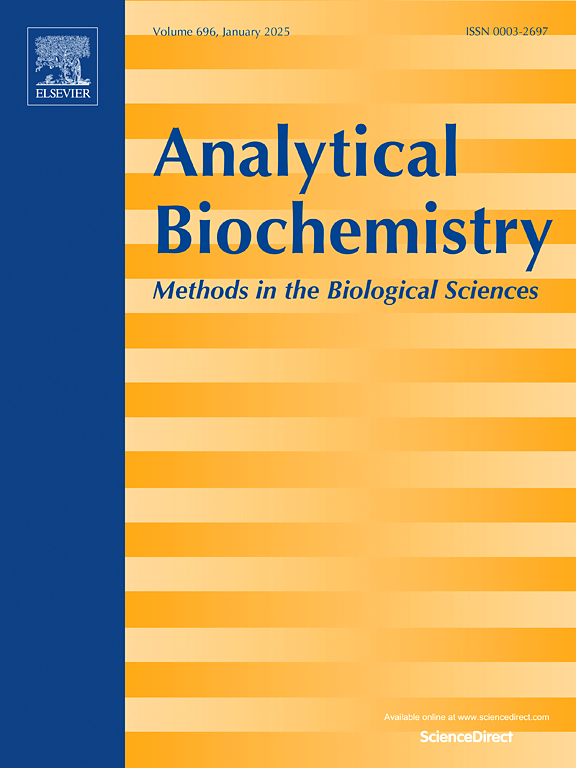一种基于免疫沉淀的方法来评估半胱氨酸-106依赖性人蛋白DJ-1在细胞系裂解物中的催化活性。
IF 2.5
4区 生物学
Q2 BIOCHEMICAL RESEARCH METHODS
引用次数: 0
摘要
DJ-1是一种具有广泛保护细胞功能的蛋白质,与从神经退行性帕金森病到癌症等多种病理有关。它的生理功能依赖于其形成蛋白质复合物的能力,以及位于酶活性位点的高度保守、氧化还原敏感的半胱氨酸残基C106。后者在防止糖酵解代谢产物修饰生物分子方面起着关键作用。然而,迄今为止,只有一种基于DJ-1高效酶解活性中间体环3-磷酸甘油酸酐(cPGA)的测定方法才能量化其在生物流体中的活性。在这项工作中,我们提出了一种新的免疫沉淀法,使用荧光来评估粗细胞裂解物中DJ-1的催化活性。该实验有效地将野生型细胞系与DJ-1敲除的细胞系区分开来,并且在五种人类细胞系裂解物中记录的活性与cPGA实验中观察到的活性具有良好的相关性。总而言之,该实验是对研究细胞裂解物中DJ-1活性和相关C106氧化还原状态工具箱的补充扩展,因为它弥补了之前实验的一些缺点。本文章由计算机程序翻译,如有差异,请以英文原文为准。

An immunoprecipitation-based assay to assess cysteine-106-dependent catalytic activity of human-protein DJ-1 in cell line lysates
DJ-1 is a protein with a wide range of protective cellular functions and implicated in several pathologies, from neurodegenerative Parkinson's disease to cancer. Its physiological functions rely on its ability to form protein complexes and on the highly conserved, redox-sensitive, cysteine residue C106 located in the enzyme's active site. The later plays a key role in the protection against the modification of biomolecules by glycolytic metabolites. However, to date, only an assay based on the highly efficient enzymatic hydrolysis of the reactive intermediate cyclic 3-phosphoglyceric anhydride (cPGA) by DJ-1 can quantify its activity in biological fluids. In this work, we propose a new immunoprecipitation assay using fluorescence to assess DJ-1 catalytic activity in crude cell lysates. This assay efficiently differentiates a wild-type cell line from its DJ-1 knock-out version, and the activity recorded in five human cell line lysates were validated by the good correlation obtained with the activities observed using the cPGA assay. To conclude, this assay is a complementary expansion to the toolbox for studying DJ-1 activity and the associated C106 redox state in cell lysates, as it makes for some of the shortcomings of the previous assay.
求助全文
通过发布文献求助,成功后即可免费获取论文全文。
去求助
来源期刊

Analytical biochemistry
生物-分析化学
CiteScore
5.70
自引率
0.00%
发文量
283
审稿时长
44 days
期刊介绍:
The journal''s title Analytical Biochemistry: Methods in the Biological Sciences declares its broad scope: methods for the basic biological sciences that include biochemistry, molecular genetics, cell biology, proteomics, immunology, bioinformatics and wherever the frontiers of research take the field.
The emphasis is on methods from the strictly analytical to the more preparative that would include novel approaches to protein purification as well as improvements in cell and organ culture. The actual techniques are equally inclusive ranging from aptamers to zymology.
The journal has been particularly active in:
-Analytical techniques for biological molecules-
Aptamer selection and utilization-
Biosensors-
Chromatography-
Cloning, sequencing and mutagenesis-
Electrochemical methods-
Electrophoresis-
Enzyme characterization methods-
Immunological approaches-
Mass spectrometry of proteins and nucleic acids-
Metabolomics-
Nano level techniques-
Optical spectroscopy in all its forms.
The journal is reluctant to include most drug and strictly clinical studies as there are more suitable publication platforms for these types of papers.
 求助内容:
求助内容: 应助结果提醒方式:
应助结果提醒方式:


